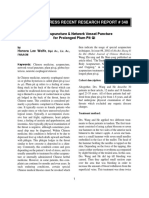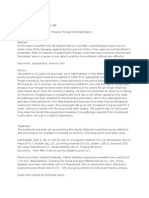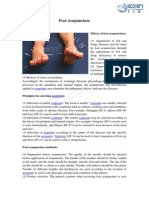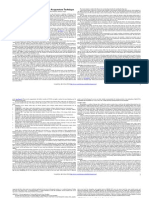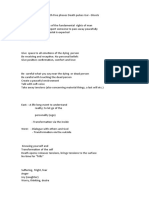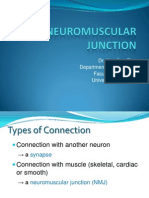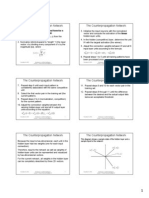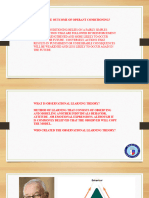Acupuncture and Addictions
Acupuncture and Addictions
Uploaded by
peter911x2134Copyright:
Available Formats
Acupuncture and Addictions
Acupuncture and Addictions
Uploaded by
peter911x2134Original Description:
Original Title
Copyright
Available Formats
Share this document
Did you find this document useful?
Is this content inappropriate?
Copyright:
Available Formats
Acupuncture and Addictions
Acupuncture and Addictions
Uploaded by
peter911x2134Copyright:
Available Formats
This article comes from a series of articles I am writing about acupuncture
and addictions (alcohol addiction, heroin addiction, meth addiction, substance
abuse, alcohol abuse, opiate addiction). Despite the doubts over the
effectiveness of acupuncture on them – that I share! - There are already
defined TCM treatments to address these problems such as alcohol addiction
treatment, addictions treatments or drug addiction treatment.
As for nicotine dependence article, this text was written based on the work of
Ganglin Yin and Zhenghua Liu, Advanced Modern Chinese Acupuncture
Therapy. Specifically addresses three different treatments that can be done
with acupuncture in the treatment of alcoholism (treatment for alcohol
abuse).
The first alcohol addiction treatment is the use of an acupuncture protocol
something complex. The authors do not explain the reason for this
acupuncture protocol. They indicate that it should only be used in alcoholic
patients, wishing to stop drinking, for alcoholism treatment. They also
indicate the type of manipulation to make to the needles (reduction) and the
number of diary treatments.
10 daily treatments make a course and the total treatment usually required
three courses. But they do not indicate more about the selection of
acupuncture points for this alcoholism acupuncture treatment. The
acupuncture alcoholism protocol presented by the authors consists of the
following acupuncture points:
SP6 (Sanyinjiao), ST40 (Fenglong), ST44 (Neiting), LV3 (Taichong) PC6
(Neiguan) SP9 (Yinlingquan) CV12 (Zhongwan) and HT7 (Shenmen).
The authors present then, separately, a governor vessel acupuncture point.
Point GV25 (Suliao) is advised in treating patients under the influence of
alcohol (drunk patients). It is advised that the insertion point at a depth of
0.2 cun and handling for 30-10 minutes.
Pay attention that this acupuncture point is used in patients under the effects
of alcohol abuse. Point GV25 (Suliao) is on the tip of the nose and has
different functions such as treating mental disorders such as hysteria, loss of
consciousness or nasal problems. In this case can be used for patients under
the influence of alcohol abuse (drunk patients).
Finally, the authors advise a dataSet of auricular acupuncture points
(auricular acupuncture). Again these acupuncture points are recommended
for alcoholic patients who want to quit and recognize they need treatment for
alcohol abuse.
The auricular acupuncture points chosen are: mouth, stomach, sanjiao,
endocrine, Shenmen, occipital subcortex, apex of the ear.
The symptoms we want to relieve can be treated in many ways. We can use
only the symptomatic acupuncture points or we can try to adapt the entire
acupuncture protocol to points dealing with the symptom when framed in a
clinical pattern.
One of the symptoms referred was sweating. To treat sweating you can
resort to acupuncture points HT6 (Yinxi), SI3 (Houxi), LI4 (hegu), KD7 (fuliu)
for example. The most often used acupuncture points to treat sweating are
SI3 (Houxi) and HT6 (Yinxi). However I can adjust these points to particular
features of the symptoms.
So if we are in summer and there is sweating with heat intolerance we can
give more attention to the point LI4 (Hegu). In winter, with cold, or if the
patient mention cold sweat I can give attention to the acupuncture point SI3
(Houxi) – opening point of the du may meridian. Point LI4 (hegu) may also
be used with moxibustion in order to help warm the body.
In this case I associate the points with specific features of the symptom
sweating to heat or cool the body. So along with point LI4 (hegu) for sweats
associated with heat I can join the 2º shu points. In the case of cold I can
associate SI3 (houxi) with moxibustion on LI4 (hegu) and GV14 as well as
use other acupuncture points such as ST36 (Zusanli).
However sweating can also be due to yin deficiency where I counsels
acupuncture point KD7 (Fuliu) or HT6 (Yinxi). Acupuncture point HT6 (Yinxi)
should be more used when there is great mental agitation or insomnia
associated while point KD7 (Fuliu) is more important when there are urinary
symptoms such as agitation with urgency to urinate.
Undoubtedly one of the major therapeutic principles in patients abstention is
to “calm the mind”. Symptoms such as irritability, insomnia or agitation are
psychological symptoms that fit into the mental sphere. The acupuncture
points will be very similar.
Combinations as GB13 (benshen) and GV24 (Shenting) are important. Distal
points as PC6 (Neiguan), HT7 (Shenmen), KD9 (zhubin) are relevant to the
extent that help calm the mind. Again an understanding of these symptoms
in a clinical pattern helps to define the most important acupuncture point in
each patient.
For example, using the underlying acupuncture protocol GV24 (Shenting),
GB13 (benshen) and Anmian for patients with major mental agitation,
irritability and insomnia, we can add acupuncture points according to the
relationship of symptoms.
In patients with heart and kidney yin deficiency we could add acupuncture
points KD6 (Zhaohai), KD9 (zhubin) and HT7 (Shenmen). In patients with
heat patterns we could add acupuncture points such as PC8 (Laogong), LI11
(guqi). In patients with patterns of liver Qi stagnation we could add up the
points GB34 (Yanglingquan), LV3 (yaichong) and PC6 (Neiguan). So we
would be with three different acupuncture protocols:
A – GB13 (benshen), GV24 (Shenting), Anmian, KD6 (Zhaohai), KD9
(zhubin), HT7 (Shenmen)
B – GB13 (benshen), GV24 (Shenting), Anmian, PC8 (Laogong), LI11 (guqi)
C – GB13 (benshen), GV24 (Shenting), Anmian, GB34 (Yanglingquan), LV3
(Taichong) PC6 (Neiguan)
It is more likely the patient has insomnia, irritability, and sweating. As such
we associate these protocols with some acupuncture points already
mentioned. The final acupuncture protocols could be:
A – GB13 (benshen), GV24 (Shenting), Anmian, KD7 (Fuliu), KD9 (zhubin),
HT6 (Yinxi), HT7 (Shenmen)
B – GB13 (benshen), GV24 (Shenting), Anmian, PC8 (Laogong), LI11 (guqi),
LI4 (hegu)
C – GB13 (benshen), GV24 (Shenting), Anmian, GB34 (Yanglingquan), LV3
(Taichong), PC6 (Neiguan), HT6 (Yinxi), SI3 (houxi)
Depending on the intensity of symptoms or the number of times a day to do
acupuncture I can switch acupuncture protocols in order to adapt them to the
needs of patients. So during the day, when the psychological agitation is
most intense I can make a protocol more focused on calming the mind. When
night sweats arise, for example, I can join the acupuncture points to calm the
mind with acupuncture points for night sweats.
There is still a symptom – in fact there are many more but I only write about
this one – which is not related to the mind or body fluids (jin ye). I speak of
physical tremors. The tremors, imagined or physically, indicate the existence
of a pattern of wind. The best way to address this clinical pattern is to use a
set of acupuncture points good enough to eliminate wind as GB20 (Fengchi),
BL10 (Tianzhu), GV16 (Fengfu) or GV20 (baihui). The advanced student or
acupuncture professional may notice that these are also the main
acupuncture points to treat dizziness or vertigo. Because for TCM these
symptoms are … wind.
You might also like
- Ques BurnoutDocument1 pageQues BurnoutFarouk Ilmid Davik100% (5)
- Wen Bing2Document9 pagesWen Bing2Jaffer Aftab0% (1)
- Abacus TrainingDocument2 pagesAbacus Trainingbujjbabu0% (1)
- R Prolonged Plum Pit QiDocument3 pagesR Prolonged Plum Pit Qipeter911x2134No ratings yet
- JCM Ashi Points ArticleDocument8 pagesJCM Ashi Points ArticleCarleta StanNo ratings yet
- Ghost SyndromesDocument7 pagesGhost Syndromespeter911x2134No ratings yet
- Multiaxial Diagnosis As Per DSM IV TR in PsychiatryDocument11 pagesMultiaxial Diagnosis As Per DSM IV TR in PsychiatryVirupaksha HG100% (1)
- AJACM 2011 6 1 Wang Juyi Interview Part 2 of 2 - LiuDocument4 pagesAJACM 2011 6 1 Wang Juyi Interview Part 2 of 2 - LiuYagtaliNo ratings yet
- Acupuncture Explained: Clearly explains how acupuncture works and what it can treatFrom EverandAcupuncture Explained: Clearly explains how acupuncture works and what it can treatNo ratings yet
- Illustrations Of Special Effective Acupoints for common DiseasesFrom EverandIllustrations Of Special Effective Acupoints for common DiseasesRating: 5 out of 5 stars5/5 (1)
- The Five Elements and Other Essential Rules in Acupuncture TreatmentFrom EverandThe Five Elements and Other Essential Rules in Acupuncture TreatmentRating: 4 out of 5 stars4/5 (4)
- Acupuncture: Ancient Treatment For Modern IllnessesDocument31 pagesAcupuncture: Ancient Treatment For Modern IllnessesJessica PaulNo ratings yet
- Acupuncture Theory e TreatmentDocument11 pagesAcupuncture Theory e TreatmentCarlos Adam Yunus100% (1)
- Acupuncture For SchizophreniaDocument28 pagesAcupuncture For SchizophreniaTomas MascaroNo ratings yet
- Qigong Acupuncture PDFDocument4 pagesQigong Acupuncture PDFjoseyangNo ratings yet
- Moxibustion For Nausea and Vomiting in PregnancyDocument11 pagesMoxibustion For Nausea and Vomiting in PregnancySiti RaihanahNo ratings yet
- Inducing Labor With AcupunctureDocument3 pagesInducing Labor With AcupunctureMichelle BrycelandNo ratings yet
- Tung Style OrthodoxDocument5 pagesTung Style OrthodoxIlinca Mihaela100% (3)
- Pattern Identification Acording To Six ChannelsDocument10 pagesPattern Identification Acording To Six ChannelsCarleta Stan100% (1)
- Acupuncture For AsthmaDocument16 pagesAcupuncture For AsthmaRichard SiahaanNo ratings yet
- TungStyleOrthodox PDFDocument5 pagesTungStyleOrthodox PDFSifu LiceNo ratings yet
- Acup 123 For Back Pain BlurbDocument5 pagesAcup 123 For Back Pain Blurbhihi12100% (1)
- Inflammation and Infection Part II: Pulse DX & Herbal TX: by Jimmy Chang, L.Ac., O.M.DDocument3 pagesInflammation and Infection Part II: Pulse DX & Herbal TX: by Jimmy Chang, L.Ac., O.M.DShahul HameedNo ratings yet
- What Are The Correspondence's Between Atopic Asthma and Giovanni Maciocia's Theory On How ... (PDFDrive)Document124 pagesWhat Are The Correspondence's Between Atopic Asthma and Giovanni Maciocia's Theory On How ... (PDFDrive)Rudolph Antony ThomasNo ratings yet
- The Neglected Art of Channel Palpation Part2Document6 pagesThe Neglected Art of Channel Palpation Part2gdupres66No ratings yet
- The Three Basic Components of A Pulse: Shape, Jump, and LevelDocument3 pagesThe Three Basic Components of A Pulse: Shape, Jump, and LevelShahul Hameed100% (1)
- Manaka HammerDocument2 pagesManaka Hammerjhonny100% (3)
- Diagrams of Acupuncture ManipulationsDocument7 pagesDiagrams of Acupuncture Manipulationsgtt_wNo ratings yet
- Acupuncture For Memory LossDocument3 pagesAcupuncture For Memory Losspeter911x100% (1)
- Qualities of A Great AcupuncturistDocument6 pagesQualities of A Great AcupuncturistKim HaslamNo ratings yet
- Huang Di Nei Jing Week 3Document3 pagesHuang Di Nei Jing Week 3Emma KerriganNo ratings yet
- The Treatment of Ovarian Hyperstimulation Syndrome (OHSS) With Acupuncture in Women Undergoing Assisted Reproductive Techniques (ART)Document9 pagesThe Treatment of Ovarian Hyperstimulation Syndrome (OHSS) With Acupuncture in Women Undergoing Assisted Reproductive Techniques (ART)InfohoggNo ratings yet
- Acupuncture Imaging 31 40 PDFDocument10 pagesAcupuncture Imaging 31 40 PDFmamun31No ratings yet
- 1996 Root and Branch Clinical ApplicationsDocument9 pages1996 Root and Branch Clinical Applicationsdoktormin106No ratings yet
- Abdominal PalpationDocument11 pagesAbdominal PalpationDoctora SantanaNo ratings yet
- Abdominal Acupuncture For DepressionDocument35 pagesAbdominal Acupuncture For DepressionAGNESE YOLOTZIN OLIVERA TORO REYESNo ratings yet
- MTMP Beg1 TC FinalDocument28 pagesMTMP Beg1 TC FinalAdriana GL100% (1)
- Foot AcupunctureDocument0 pagesFoot Acupuncturerasputin22No ratings yet
- Hmccann Hatung LN PDFDocument9 pagesHmccann Hatung LN PDFMiguel A Cordero100% (1)
- Scalp Acupuncture WFAS PDFDocument7 pagesScalp Acupuncture WFAS PDFYoshua ViventiusNo ratings yet
- Acupuncture Repairs Injured NervesDocument5 pagesAcupuncture Repairs Injured NervesSergio SCNo ratings yet
- Wrist and Ankle AcupunctureDocument11 pagesWrist and Ankle AcupunctureSreekanth Krishnamurthy100% (1)
- Anxiety 4Document10 pagesAnxiety 4peter911x2134No ratings yet
- Tai Yin MT PointsDocument12 pagesTai Yin MT PointspauloasvNo ratings yet
- Course C Basic Theories of Acupuncture and MoxibustionDocument36 pagesCourse C Basic Theories of Acupuncture and MoxibustionGermey HoongNo ratings yet
- Case 2 - Acute Back PainDocument4 pagesCase 2 - Acute Back PainJohn Fightakis100% (1)
- DR - Zhu Scalp AcupunctureDocument25 pagesDR - Zhu Scalp AcupunctureMajid Mushtaq100% (5)
- The Journal of Chinese Medicine and AcupunctureDocument56 pagesThe Journal of Chinese Medicine and Acupuncturemartin sandaNo ratings yet
- Sample Case Study Based On Actual PatientDocument6 pagesSample Case Study Based On Actual PatientRamalingam ChandrasekharanNo ratings yet
- RCP - Post Stroke Scalp Acupuncture Research PDFDocument64 pagesRCP - Post Stroke Scalp Acupuncture Research PDFIstiqomah Flx100% (1)
- Hypochondriac Pain in TCMDocument3 pagesHypochondriac Pain in TCMJorge Enrique TigrerosNo ratings yet
- Pedlatrlc Acupuncture Chinese Medicine KTCMDocument363 pagesPedlatrlc Acupuncture Chinese Medicine KTCMSanté Kine Yoga-thérapieNo ratings yet
- Bleeding Peripheral Points. An Acupuncture TechniqueDocument6 pagesBleeding Peripheral Points. An Acupuncture TechniqueSanjay PatilNo ratings yet
- Final Three Yellows Article 3-6-10Document3 pagesFinal Three Yellows Article 3-6-10superser123465No ratings yet
- An Interview With Robert ChuDocument4 pagesAn Interview With Robert ChuJesús Villegas100% (2)
- Acupuncture For BurnsDocument34 pagesAcupuncture For BurnsIvonne Flores FernándezNo ratings yet
- Balance Notes PDFDocument4 pagesBalance Notes PDFFarhan Ullah Khan100% (2)
- Acupuncture and Moxibustion Techniques PDFDocument71 pagesAcupuncture and Moxibustion Techniques PDFJessé de Andrade100% (2)
- Acupuncture For Acute Management and Rehabilitation of Traumatic Brain InjuryDocument10 pagesAcupuncture For Acute Management and Rehabilitation of Traumatic Brain InjuryTomas Mascaro0% (1)
- A Study of The Sa-Ahm Five Element Acupuncture Theory: December 2009Document13 pagesA Study of The Sa-Ahm Five Element Acupuncture Theory: December 2009dtncorreoNo ratings yet
- Enuresia Bob FLawsDocument2 pagesEnuresia Bob FLawssofeli100% (1)
- Convex-Shaped Pulses: by Jimmy Wei-Yen Chang, L.AcDocument3 pagesConvex-Shaped Pulses: by Jimmy Wei-Yen Chang, L.AcShahul HameedNo ratings yet
- Large Intestine: Actions & EffectsDocument5 pagesLarge Intestine: Actions & EffectsElizabeth Durkee Neil100% (1)
- Other Acupuncture Reflection 3Document20 pagesOther Acupuncture Reflection 3peter911x2134No ratings yet
- Other Acupuncture IntroductionDocument7 pagesOther Acupuncture Introductionpeter911x2134No ratings yet
- Professor QIN Liang-Fu' S Clinical Experience:Using Governor Vessel To Treat Miscellaneous DiseasesDocument1 pageProfessor QIN Liang-Fu' S Clinical Experience:Using Governor Vessel To Treat Miscellaneous Diseasespeter911x2134No ratings yet
- Other Acupuncture Reflection 4Document13 pagesOther Acupuncture Reflection 4peter911x2134No ratings yet
- Drugs and Acupuncture: The Energetic Impact of Antidepressant MedicationsDocument7 pagesDrugs and Acupuncture: The Energetic Impact of Antidepressant Medicationspeter911x2134No ratings yet
- Efficacy of TCM Therapy of Claustrophobia - A Case Report PDFDocument5 pagesEfficacy of TCM Therapy of Claustrophobia - A Case Report PDFpeter911x2134No ratings yet
- Discovery of The Healing HighwayDocument2 pagesDiscovery of The Healing Highwaypeter911x2134No ratings yet
- Disorders of ConsiousnessDocument27 pagesDisorders of Consiousnesspeter911x2134No ratings yet
- Elation and JoyDocument10 pagesElation and Joypeter911x2134No ratings yet
- Elisabeth RochatDocument66 pagesElisabeth Rochatpeter911x21340% (1)
- Relevant Western Diseases:: Liver Qi Overacting On Spleen & Stomach Affecting Brain ShenDocument2 pagesRelevant Western Diseases:: Liver Qi Overacting On Spleen & Stomach Affecting Brain Shenpeter911x2134No ratings yet
- Guidance Life and Death Five Phases Death Pulses GuiDocument24 pagesGuidance Life and Death Five Phases Death Pulses Guipeter911x2134No ratings yet
- Globus HystericusDocument1 pageGlobus Hystericuspeter911x2134No ratings yet
- GuiltDocument3 pagesGuiltpeter911x2134No ratings yet
- Chronic Schizophrenia 2'Document1 pageChronic Schizophrenia 2'peter911x2134No ratings yet
- Differential Diagnosis:: Heart - Spleen Dual VacuityDocument2 pagesDifferential Diagnosis:: Heart - Spleen Dual Vacuitypeter911x2134No ratings yet
- Neuromuscular JunctionDocument23 pagesNeuromuscular Junctionkiedd_04100% (8)
- Case Study # 1 - The Case of GenieDocument2 pagesCase Study # 1 - The Case of GenieKelcie BoringNo ratings yet
- 3 Microglia-Mediated T Cell Infiltration Drives Neurodegeneration in TauopathyDocument31 pages3 Microglia-Mediated T Cell Infiltration Drives Neurodegeneration in TauopathyWinky FongNo ratings yet
- Personal Characteristics of An Effective CounselorDocument1 pagePersonal Characteristics of An Effective CounselorMichael John CanoyNo ratings yet
- The Counterpropagation Network The Counterpropagation NetworkDocument3 pagesThe Counterpropagation Network The Counterpropagation NetworkKirtesh SharmaNo ratings yet
- Introduction To Convolutional Neural NetworksDocument41 pagesIntroduction To Convolutional Neural NetworksRashiNo ratings yet
- Act. No. 02 Visual Acuity and PerceptionDocument5 pagesAct. No. 02 Visual Acuity and PerceptionCypris Mae MasongNo ratings yet
- History Taking and Physical Examination IN Diagnosing of Neurologic DisordersDocument44 pagesHistory Taking and Physical Examination IN Diagnosing of Neurologic DisordersRadityaRezhaNo ratings yet
- The Impact of Music On The Academic Performance of Undergraduate Students - Corrected 12 June 2018Document112 pagesThe Impact of Music On The Academic Performance of Undergraduate Students - Corrected 12 June 2018sharksharkNo ratings yet
- # 2 The Childen and Adolescents Learners and Learning Principles Module 2Document32 pages# 2 The Childen and Adolescents Learners and Learning Principles Module 2Clarissa BustardeNo ratings yet
- A New Model For Measuring Advertising EffectivenessDocument10 pagesA New Model For Measuring Advertising EffectivenessShahriar AziziNo ratings yet
- Curriculum Plannin Question&AnswerDocument3 pagesCurriculum Plannin Question&AnswerJirah Joy PeañarNo ratings yet
- Delhi Previous Year QpsDocument309 pagesDelhi Previous Year QpsPriNo ratings yet
- Diabetic NeuropathyDocument10 pagesDiabetic Neuropathyrafael rocha novaesNo ratings yet
- The Inner World in The Outer World 565089838Document266 pagesThe Inner World in The Outer World 565089838ramona100% (1)
- Self Injury Interventions.08Document6 pagesSelf Injury Interventions.08Dana ScullyNo ratings yet
- Materi 3 - Problem SituationDocument20 pagesMateri 3 - Problem SituationFerren Liling SiaNo ratings yet
- Reading Comprehension - Sleep CycleDocument2 pagesReading Comprehension - Sleep CycleMartin HauserNo ratings yet
- Academic Motivation and Self-Efficacy Among Public School Senior High School Students: A Correlational StudyDocument6 pagesAcademic Motivation and Self-Efficacy Among Public School Senior High School Students: A Correlational StudyPsychology and Education: A Multidisciplinary JournalNo ratings yet
- Simple Muscle Twitch (Practical Physiology)Document28 pagesSimple Muscle Twitch (Practical Physiology)Jana Encabo50% (2)
- Curriculum de Psicoterapia para Estudiantes de MedicinaDocument5 pagesCurriculum de Psicoterapia para Estudiantes de MedicinapsychforallNo ratings yet
- Chapter 3Document3 pagesChapter 3Jane SandovalNo ratings yet
- Markant Scott 2018 Attention and Perceptual Learning Interact in The Development of The Other Race EffectDocument7 pagesMarkant Scott 2018 Attention and Perceptual Learning Interact in The Development of The Other Race EffectaavscribdNo ratings yet
- A Study On The Impact of Emotional Intelligence On Quality of Life Among Secondary School TeachersDocument14 pagesA Study On The Impact of Emotional Intelligence On Quality of Life Among Secondary School TeachersYushikaMittalNo ratings yet
- 02 - Establishing High Quality Classroom AssessmentDocument29 pages02 - Establishing High Quality Classroom AssessmentDiether Añonuevo DavidNo ratings yet
- Gibbs' Prompts For Structured Debriefing Description of A SituationDocument48 pagesGibbs' Prompts For Structured Debriefing Description of A SituationShibli LondonNo ratings yet
- Stahl' Essential Psychopharmacology 285Document1 pageStahl' Essential Psychopharmacology 285Muhammad AzkaNo ratings yet



